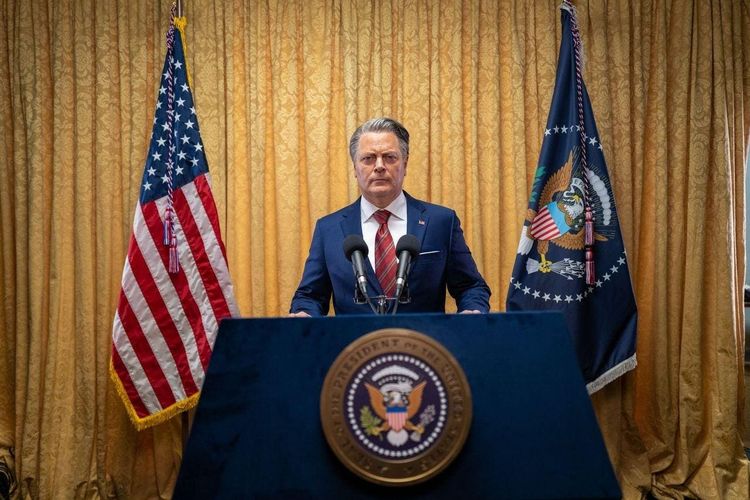Does 'Civil War' Have An End Credits Scene?

The U.S. president (Nick Offerman) in "Civil War."
A24Civil War — writer-director Alex Garland’s provocative cautionary tale about deadly civil unrest in a dystopian future U.S. — is new in theaters. But is there an end credits scene to indicate if the unnerving war tale will continue?
The film is now in theaters following its high-profile premiere at the 2024 SXSW Film Festival in Austin, Texas, in March.
Civil War stars Kirsten Dunst as Lee Smith, a veteran war photojournalist whose latest assignment hits too close to home. The violent conflict is set in a politically and geographically divided America that’s under the rule of a dictatorial third-term president (Nick Offerman).
While the film ends with a definitive conclusion, it’s conceivable that a sequel could be made for Civil War. After all, wars are messy and despite proclamations of victory in conflicts over the decades — if not centuries — some battles truly never end.
Of course, scenes that pop up after the conclusion of a film generally indicate that a sequel is in the works and to that end, there are no end credit scenes in Civil War. However, Garland does manage to take a creative, visual approach that accompanies the end credits instead of showing an additional scene.
Since Civil War chronicles the work of still photographers Lee and her protégé Jessie (Cailee Spaeny), the end credits begin with a photo taken by one of the photojournalists during the climactic final scene of the film. The photo slowly develops as the end credits start to roll and eventually it becomes fully exposed to display a haunting image.
What is ‘Civil War’ About?Civil War chronicles a battle in a not-so-distant future where Texas and California have seceded from the U.S. to form a group called the Western Forces. The goal of the WF is to blaze a trail across the country to Washington, D.C., where the group plans to overthrow the U.S. president (Nick Offerman), who is not identified by name.
Following a horrific incident that resulted in multiple deaths and mass casualties in in New York City, photojournalist Lee Smith (Kirsten Dunst) sets off to Washington, D.C., with a pair of reporters Joel (Wagner Moura) and Sammy (Stephen McKinley Henderson). The group’s objective is to interview and get photos of the president — who hasn’t talked with the press in 14 months — before any rebel factions reach him.
Tagging along on the dangerous assignment with the group — which has been warned that journalists are shot on sight in the nation’s capital — is Jessie (Cailee Spaeny), an inexperienced but fearless photographer Lee saves from harm during a violent protest in New York City. However — as the group finds out on their way to Washington, D.C. — the looks of the warring factions are indistinguishable, which means any of the journalists could die without warning.
Since journalists were allowed to publish their reviews of Civil War following the film’s premiere at SXSW, several critiques of the film have been posted already on Rotten Tomatoes. To date, Civil War has scored a “fresh” 87 percent rating on the site’s Tomatometer based on 135 reviews, while the audience score is pending.
Perhaps the most surprising aspect of Civil War is that it was clearly designed to start conversations and not stir further political divide. Not only does Civil War avoid any dialogue about any political ideologies or arguments over cultural elements, but it also purposefully avoids identifying either the Democratic or Republican parties.
Perhaps the most telling sign that the film isn’t willing to take sides — and chooses to unnervingly focus on the horrors of war instead — is how the story finds a red state (Texas) and a blue state (California) teaming together for the WF secessionist movement.
Civil War is playing in theaters.

















































